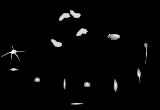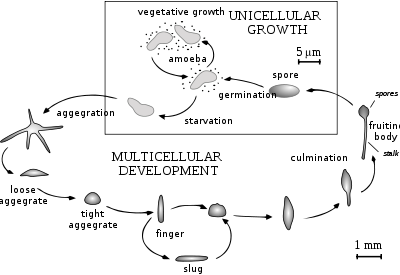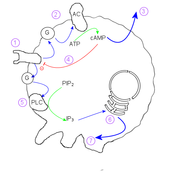
Dictyostelid
Encyclopedia
The dictyostelids are a group of cellular slime molds, or social amoeba
e.
, or slug (not to be confused with the gastropod
mollusc
called a slug
). The slug has a definite anterior and posterior, responds to light and temperature gradients, and has the ability to migrate. Under the correct circumstances the slug matures forming a sporocarp
(fruiting body) with a stalk supporting one or more sori (balls of spores). These spores are inactive cells protected by resistant cell walls, and become new amoebae once food is available.
In Acytostelium, the sporocarp
is supported by a stalk composed of cellulose
, but in other dictyostelids the stalk is composed of cells, sometimes taking up the majority of the original amoebae. With a few exceptions, these cells die during stalk formation, and there is a definite correspondence between parts of the slug and parts of the fruiting body. Aggregation of amoebae generally takes place in converging streams. The amoebae move using filose pseudopod
s, and are attracted to chemicals produced by other amoebae. In Dictyostelium, aggregation is signalled by cAMP, but others use different chemicals. In the species Dictyostelium purpureum
, the grouping is by kinship, not just by proximity.
in molecular biology
and genetics
, and is studied as an example of cell communication, differentiation
, and programmed cell death
. It is also an interesting example of the evolution of cooperation and cheating. A large body of research data concerning D. discoideum
is available on-line at DictyBase
.

 The mechanism behind the aggregation of the amoebae relies on Cyclic adenosine monophosphate
The mechanism behind the aggregation of the amoebae relies on Cyclic adenosine monophosphate
(cAMP) as a signal molecule. One cell, the founder of the colony, begins to secrete cAMP in response to stress. Others detect this signal, and respond in two ways:
The effect of this is to relay the signal throughout the nearby population of amoebae and cause inward movement to the area of highest cAMP concentration.
Within an individual cell, the mechanism is as follows:
Because the internal cAMP concentration inactivates the receptor for external cAMP, an individual cell shows oscillatory
behaviour. This behaviour produces beautiful spirals seen in converging colonies and is reminiscent of the Belousov-Zhabotinsky reaction
and two-dimensional cyclic cellular automata.
was published in Nature
in 2005 by geneticist Ludwig Eichinger and coworkers. The haploid genome contains approximately 12,500 genes on 6 chromosomes. For comparison, the diploid human genome
has 20,000-25,000 genes (represented twice) on 23 chromosome pairs. There is a high level of the nucleotides adenosine and thymidine
(~77%) leading to a codon usage that favors more adenosines and thymidines in the third position. Tandem repeats of trinucleotides are abundant in Dictyostelium, which in humans cause Trinucleotide repeat disorders
.
First discovered in a North Carolina forest in 1935, Dictyostelium discoideum was at first classified under 'lower fungi.' and in subsequent years into the kingdoms Protoctista, Fungi and Tubulomitochondrae. By the 1990s, most scientists accepted the current classification.
Amoebozoa are now considered by most to form a separate kingdom-level clade, being more closely related to both animals and fungi than to plants.
. The cytoskeletal composition of D. discoideum is similar to that of mammalian cells as are the processes driven by these components, such as phagocytosis, membrane trafficking, endocytic transit and vesicle sorting. Like leukocytes, D. discoideum possess chemotactic capacity. Hence, D. discoideum represents a suitable model system to ascertain the influence of a variety of host cell factors during Legionella
infections.
Amoeba
Amoeba is a genus of Protozoa.History=The amoeba was first discovered by August Johann Rösel von Rosenhof in 1757. Early naturalists referred to Amoeba as the Proteus animalcule after the Greek god Proteus, who could change his shape...
e.
Slug behavior
When food (normally bacteria) is readily available they are individual amoebae, which feed and divide normally. However when the food supply is exhausted, they aggregate to form a multicellular assembly, called a pseudoplasmodium, grexGrex (biology)
A grex is a multicellular aggregate of amoeba of the groups Acrasiomycota or Dictyosteliida that can be formed when the amoeba run out of food. It takes its form when the column formed from the aggregation of cells collapses due to its height, and becomes a slug-shaped mass...
, or slug (not to be confused with the gastropod
Gastropoda
The Gastropoda or gastropods, more commonly known as snails and slugs, are a large taxonomic class within the phylum Mollusca. The class Gastropoda includes snails and slugs of all kinds and all sizes from microscopic to quite large...
mollusc
Mollusca
The Mollusca , common name molluscs or mollusksSpelled mollusks in the USA, see reasons given in Rosenberg's ; for the spelling mollusc see the reasons given by , is a large phylum of invertebrate animals. There are around 85,000 recognized extant species of molluscs. Mollusca is the largest...
called a slug
Slug
Slug is a common name that is normally applied to any gastropod mollusc that lacks a shell, has a very reduced shell, or has a small internal shell...
). The slug has a definite anterior and posterior, responds to light and temperature gradients, and has the ability to migrate. Under the correct circumstances the slug matures forming a sporocarp
Sporocarp
Sporocarp can refer to any of several structures whose primary function is the production and release of spores.* Sporocarp , a multicellular structure on which spore-producing structures are borne....
(fruiting body) with a stalk supporting one or more sori (balls of spores). These spores are inactive cells protected by resistant cell walls, and become new amoebae once food is available.
In Acytostelium, the sporocarp
Sporocarp
Sporocarp can refer to any of several structures whose primary function is the production and release of spores.* Sporocarp , a multicellular structure on which spore-producing structures are borne....
is supported by a stalk composed of cellulose
Cellulose
Cellulose is an organic compound with the formula , a polysaccharide consisting of a linear chain of several hundred to over ten thousand β linked D-glucose units....
, but in other dictyostelids the stalk is composed of cells, sometimes taking up the majority of the original amoebae. With a few exceptions, these cells die during stalk formation, and there is a definite correspondence between parts of the slug and parts of the fruiting body. Aggregation of amoebae generally takes place in converging streams. The amoebae move using filose pseudopod
Pseudopod
Pseudopods or pseudopodia are temporary projections of eukaryotic cells. Cells that possess this faculty are generally referred to as amoeboids. Pseudopodia extend and contract by the reversible assembly of actin subunits into microfilaments...
s, and are attracted to chemicals produced by other amoebae. In Dictyostelium, aggregation is signalled by cAMP, but others use different chemicals. In the species Dictyostelium purpureum
Dictyostelium purpureum
Dictyostelium purpureum is a species of Dictyostelium.D.purpureum is a distinct species from D. discoideum, although it belongs in the same phenotypic grouping. Like D. discoideum, it exhibits a robust multicellular life cycle, and shares some of the early signaling molecules with D. discoideum...
, the grouping is by kinship, not just by proximity.
Uses as model organism
Dictyostelium has been used as a model organismModel organism
A model organism is a non-human species that is extensively studied to understand particular biological phenomena, with the expectation that discoveries made in the organism model will provide insight into the workings of other organisms. Model organisms are in vivo models and are widely used to...
in molecular biology
Molecular biology
Molecular biology is the branch of biology that deals with the molecular basis of biological activity. This field overlaps with other areas of biology and chemistry, particularly genetics and biochemistry...
and genetics
Molecular genetics
Molecular genetics is the field of biology and genetics that studies the structure and function of genes at a molecular level. The field studies how the genes are transferred from generation to generation. Molecular genetics employs the methods of genetics and molecular biology...
, and is studied as an example of cell communication, differentiation
Cellular differentiation
In developmental biology, cellular differentiation is the process by which a less specialized cell becomes a more specialized cell type. Differentiation occurs numerous times during the development of a multicellular organism as the organism changes from a simple zygote to a complex system of...
, and programmed cell death
Programmed cell death
Programmed cell-death is death of a cell in any form, mediated by an intracellular program. PCD is carried out in a regulated process which generally confers advantage during an organism's life-cycle...
. It is also an interesting example of the evolution of cooperation and cheating. A large body of research data concerning D. discoideum
Dictyostelium discoideum
Dictyostelium discoideum is a species of soil-living amoeba belonging to the phylum Mycetozoa. D. discoideum, commonly referred to as slime mold, is a eukaryote that transitions from a collection of unicellular amoebae into a multicellular slug and then into a fruiting body within its lifetime. D...
is available on-line at DictyBase
DictyBase
is an online bioinformatics database for the model organism Dictyostelium discoideum.-Tools:dictyBase offers many ways of searching and retrieving data from the database:...
.

Mechanism of aggregation in Dictyostelium

Cyclic adenosine monophosphate
Cyclic adenosine monophosphate is a second messenger important in many biological processes...
(cAMP) as a signal molecule. One cell, the founder of the colony, begins to secrete cAMP in response to stress. Others detect this signal, and respond in two ways:
- The amoeba moves towards the signal.
- The amoeba secretes more cAMP to boost the signal.
The effect of this is to relay the signal throughout the nearby population of amoebae and cause inward movement to the area of highest cAMP concentration.
Within an individual cell, the mechanism is as follows:
- cAMP reception at the cell membrane activates a G-protein
- G protein stimulates Adenylate cyclaseAdenylate cyclaseAdenylate cyclase is part of the G protein signalling cascade, which transmits chemical signals from outside the cell across the membrane to the inside of the cell ....
- cAMP diffuses out of cell into medium
- Internal cAMP inactivates the external cAMP receptor.
- A different g-protein stimulates Phospholipase CPhospholipaseA phospholipase is an enzyme that hydrolyzes phospholipids into fatty acids and other lipophilic substances. There are four major classes, termed A, B, C and D, distinguished by the type of reaction which they catalyze:*Phospholipase A...
- IP3 induces calcium ion release
- Calcium ions act on the cytoskeletonCytoskeletonThe cytoskeleton is a cellular "scaffolding" or "skeleton" contained within a cell's cytoplasm and is made out of protein. The cytoskeleton is present in all cells; it was once thought to be unique to eukaryotes, but recent research has identified the prokaryotic cytoskeleton...
to induce the extension of pseudopodPseudopodPseudopods or pseudopodia are temporary projections of eukaryotic cells. Cells that possess this faculty are generally referred to as amoeboids. Pseudopodia extend and contract by the reversible assembly of actin subunits into microfilaments...
ia.
Because the internal cAMP concentration inactivates the receptor for external cAMP, an individual cell shows oscillatory
Oscillation
Oscillation is the repetitive variation, typically in time, of some measure about a central value or between two or more different states. Familiar examples include a swinging pendulum and AC power. The term vibration is sometimes used more narrowly to mean a mechanical oscillation but sometimes...
behaviour. This behaviour produces beautiful spirals seen in converging colonies and is reminiscent of the Belousov-Zhabotinsky reaction
Belousov-Zhabotinsky reaction
A Belousov–Zhabotinsky reaction, or BZ reaction, is one of a class of reactions that serve as a classical example of non-equilibrium thermodynamics, resulting in the establishment of a nonlinear chemical oscillator. The only common element in these oscillating systems is the inclusion of bromine...
and two-dimensional cyclic cellular automata.
Genome
The entire genome of Dictyostelium discoideumDictyostelium discoideum
Dictyostelium discoideum is a species of soil-living amoeba belonging to the phylum Mycetozoa. D. discoideum, commonly referred to as slime mold, is a eukaryote that transitions from a collection of unicellular amoebae into a multicellular slug and then into a fruiting body within its lifetime. D...
was published in Nature
Nature
Nature, in the broadest sense, is equivalent to the natural world, physical world, or material world. "Nature" refers to the phenomena of the physical world, and also to life in general...
in 2005 by geneticist Ludwig Eichinger and coworkers. The haploid genome contains approximately 12,500 genes on 6 chromosomes. For comparison, the diploid human genome
Human genome
The human genome is the genome of Homo sapiens, which is stored on 23 chromosome pairs plus the small mitochondrial DNA. 22 of the 23 chromosomes are autosomal chromosome pairs, while the remaining pair is sex-determining...
has 20,000-25,000 genes (represented twice) on 23 chromosome pairs. There is a high level of the nucleotides adenosine and thymidine
Thymidine
Thymidine is a chemical compound, more precisely a pyrimidine deoxynucleoside. Deoxythymidine is the DNA nucleoside T, which pairs with deoxyadenosine in double-stranded DNA...
(~77%) leading to a codon usage that favors more adenosines and thymidines in the third position. Tandem repeats of trinucleotides are abundant in Dictyostelium, which in humans cause Trinucleotide repeat disorders
Trinucleotide repeat disorders
Trinucleotide repeat disorders are a set of genetic disorders caused by trinucleotide repeat expansion, a kind of mutation where trinucleotide repeats in certain genes exceeding the normal, stable, threshold, which differs per gene...
.
Classification
The first dictyostelid to be described was Dictyostelium mucoroides in 1869 by Oskar Brefeld .First discovered in a North Carolina forest in 1935, Dictyostelium discoideum was at first classified under 'lower fungi.' and in subsequent years into the kingdoms Protoctista, Fungi and Tubulomitochondrae. By the 1990s, most scientists accepted the current classification.
Amoebozoa are now considered by most to form a separate kingdom-level clade, being more closely related to both animals and fungi than to plants.
Model Host Organism for Legionella
Dictyostelium shares many molecular features with macrophages, the human host of LegionellaLegionella
Legionella is a pathogenic Gram negative bacterium, including species that cause legionellosis or Legionnaires' disease, most notably L. pneumophila. It may be readily visualized with a silver stain....
. The cytoskeletal composition of D. discoideum is similar to that of mammalian cells as are the processes driven by these components, such as phagocytosis, membrane trafficking, endocytic transit and vesicle sorting. Like leukocytes, D. discoideum possess chemotactic capacity. Hence, D. discoideum represents a suitable model system to ascertain the influence of a variety of host cell factors during Legionella
Legionella
Legionella is a pathogenic Gram negative bacterium, including species that cause legionellosis or Legionnaires' disease, most notably L. pneumophila. It may be readily visualized with a silver stain....
infections.
External links
- Dictyostelium (2007)
- Low Society (2004)
- dictyBase Online Informatics Resource for Dictyostelium
- dictyBase wiki official wiki site for dictyBase
- Dictyostelium discoideum Genome Project
- Dictyostelium discoideum description, life cycle

